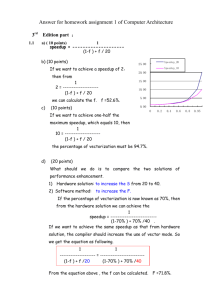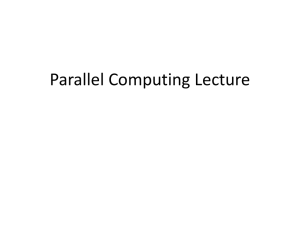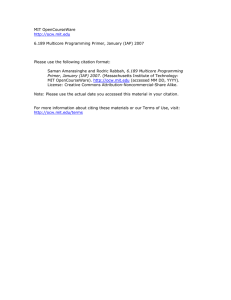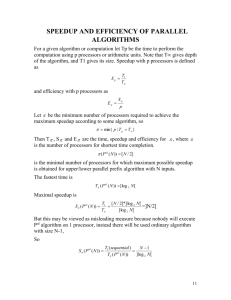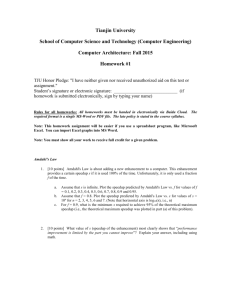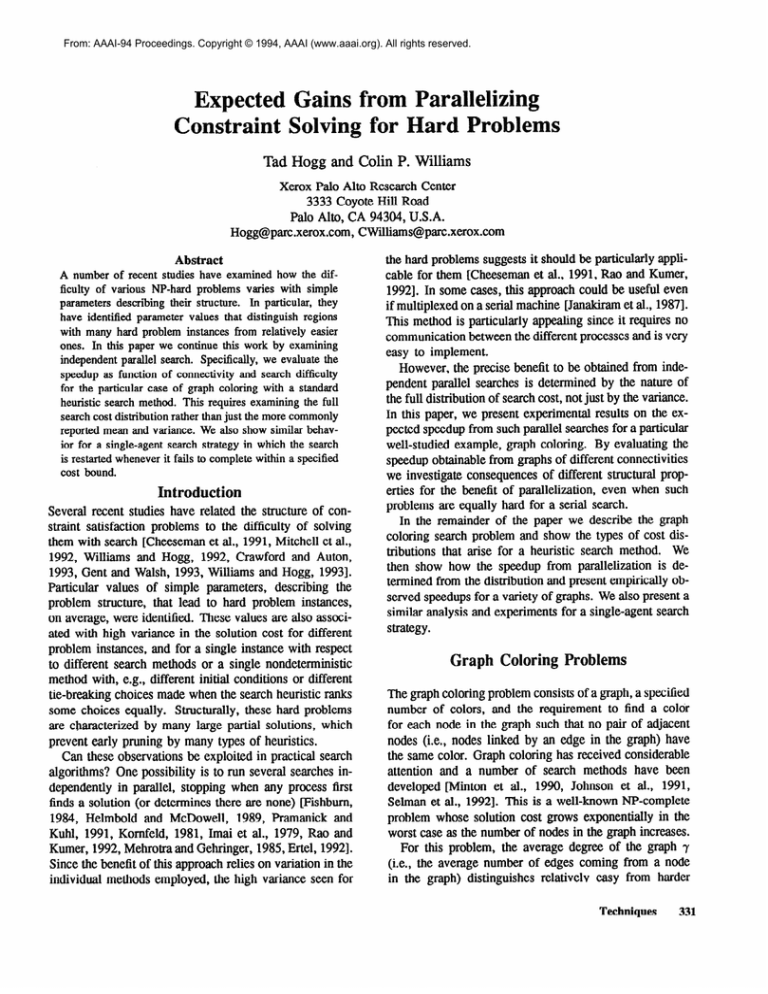
From: AAAI-94 Proceedings. Copyright © 1994, AAAI (www.aaai.org). All rights reserved.
Expected Gains from Parallelizing
Constraint Solving for
Tad Hogg and Colin P. Williams
Xerox Palo Alto Research Center
3333 Coyote Hill Road
Palo Alto, CA 94304, U.S.A.
Hogg@parc.xerox.com, CWilliams@parc.xerox.com
Abstract
A number of recent studies have examined how the difficulty of various NP-hard problems varies with simple
parameters describing their structure. In particular, they
have identified parameter values that distinguish regions
with many hard problem instances from relatively easier
ones. In this paper we continue this work by examining
independent parallel search. SpecificalIy, we evaluate the
speedup as function of connectivity and search difficulty
for the particular case of graph coloring with a standard
heuristic search method. This requires examining the full
search cost distribution rather than just the more commonly
reported mean and variance. We also show similar behavior for a single-agent search strategy in which the search
is restarted whenever it fails to complete within a specified
cost bound.
troduction
Several recent studies have related the structure of constraint satisfaction problems to the difficulty of solving
them with search [Cheeseman et al., 1991, Mitchell et al.,
1992, Williams and Hogg, 1992, Crawford and Auton,
1993, Gent and Walsh, 1993, Williams and Hogg, 19931.
Particular values of simple parameters, describing the
problem structure, that lead to hard problem instances,
on average, were identified. These values are also associated with high variance in the solution cost for different
problem instances, and for a single instance with respect
to different search methods or a single nondeterministic
method with, e.g., different initial conditions or different
tie-breaking choices made when the search heuristic ranks
some choices equally. Structurally, these hard problems
are characterized by many large partial solutions, which
prevent early pruning by many types of heuristics.
Can these observations be exploited in practical search
algorithms? One possibility is to run several searches independently in parallel, stopping when any process first
finds a solution (or determines there are none) [Fishburn,
1984, Helmbold and McDowell, 1989, Pramaniclc and
Kuhl, 1991, Kornfeld, 1981, Imai et al., 1979, Rao and
Kumer, 1992, Mehrotra and Gehringer, 1985, Ertel, 19921.
Since the benefit of this approach relies on variation in the
individual methods employed, the high variance seen for
the hard problems suggests it should be particularly applicable for them [Cheeseman et al., 1991, Rao and Kumer,
19921. In some cases, this approach could be useful even
if multiplexed on a serial machine [Janakiram et al., 19871.
This method is particularly appealing since it requires no
communication between the different processes and is very
easy to implement.
However, the precise benefit to be obtained from independent parallel searches is determined by the nature of
the full distribution of search cost, not just by the variance.
In this paper, we present experimental results on the expected speedup from such parallel searches for a particular
well-studied example, graph coloring. By evaluating the
speedup obtainable from graphs of different connectivities
we investigate consequences of different structural properties for the benefit of parallelization, even when such
problems are equally hard for a serial search.
In the remainder of the paper we describe the graph
coloring search problem and show the types of cost distributions that arise for a heuristic search method. We
then show how the speedup from parallelization is determined from the distribution and present empirically observed speedups for a variety of graphs. We also present a
similar analysis and experiments for a single-agent search
strategy.
Graph Coloring Problems
The graph coloring problem consists of a graph, a specified
number of colors, and the requirement to find a color
for each node in the graph such that no pair of adjacent
nodes (i.e., nodes linked by an edge in the graph) have
the same color. Graph coloring has received considerable
attention and a number of search methods have been
developed [Minton et al., 1990, Johnson et al., 1991,
Selman et al., 19921. This is a well-known NP-complete
problem whose solution cost grows exponentially in the
worst case as the number of nodes in the graph increases.
For this problem, the average degree of the graph y
(i.e., the average number of edges coming from a node
in the graph) distinguishes relativelv easy from harder
Techniques
331
problem2, on average. In this paper, we focus on the case
of 3-coloring (i.e., when 3 different colors are available).
In our experiments we used a complete, depth-first
backtracking search based on the Brelaz heuristic [Johnson
et al., 19911 which assigns the most constrained nodes first
(i.e., those with the most distinctly colored neighbors),
breaking ties by choosing nodes with the most uncolored
neighbors (with any remaining ties broken randomly). For
each node, the smallest color consistent with the previous
assignments is chosen first, with successive choices made
when the search is forced to backtrack. This complete
search method is guaranteed to eventually terminate and
produce correct results.
the occasional high-cost instance, the mean search cost is
relatively large. On the other hand, we found more tightly
clustered distributions in which all the searches required
about the same, large cost. As described below, these distinct distribution shapes give rise to very different potential
for parallel speedup through multiple searches.
lo3
2
$0
2
0101
The Cost Distribution
For our experiments we used randomly generated graphs
with 100 nodes and with a specified average connectivity
y. For these problems, there are two distinct regions with
hard problems. The first, near y = 4.5 has a fairly high
density of hard instances. The second, at somewhat lower
connectivities, has mostly easy problems but occasionally
instances with extremely high search costs. These extreme
cases have such large cost that they dominate the mean
cost in this region. These observations are summarized
in Fig. 1.
10°
0
30000
10000
50000
cost
6
5
24
:3
O2
1
0
50000
55000
60000
65000
cost
2
4
3
5
6
connectivity
Fig. 1. Search cost as a function of avera e connectivity y of the
graphs with 100 nodes. The black curve s ttows the mean cost and
the gray one is the median cost. Values are shown in increments
of 0.1 for y and are based on 50,000 samples at each point.
The large variance in search cost for the lower connectivities
produces the sharp peaks in the mean cost, an indication that
many more samples are required to determine it accurately.
For the behavior of parallel search we need to consider
the distribution of search costs. For the cases in which a
single search solves the problem rapidly there is not much
to be gained from parallel methods. ‘Thus we focus on the
behavior of problems in the hard regions of intermediate
connectivity. Fig. 2 gives examples of the types of cost
distribution we encountered. Specifically, there were two
distinct shapes. On one hand, we found multimodal distributions with a wide range of individual costs. In these
cases, the search often completes rapidly but because of
332
Constraint Satisfaction
Fig. 2. The search cost distribution for two lOGnode graphs
with y = 3.5. In each case, the graph was searched 10,000
times.
The plots give the number of times each cost was
found. The first case is a multimodal distribution with average
cost Tl = 15122 and a large possible speedup: S(10) = 76,
S opt = 37 with r* = 412.
The second case is a fairly
unimodal distribution (note the ex anded cost scale on
sh
the“rf:orizontal axis). It has average cost f 1 = 55302 and very
limited speedup: S( 10) = 1.1 and Sopt = 1 with no cutoff (i.e.,
r* = 00). These quantities are defined in Eqs. 1 and 3.
Speedup with
When a heuristic search involves some random choices, repeated runs on the same problem can give different search
costs. This is especially true when incorrect choices made
early in the search are undone only after a large number of
steps. In such cases, one could benefit from running multiple, independent versions of the search, stopping when
the first one completes. In this section, we show how the
expected speedup for this method is determined by the full
cost distribution of the search method.
Specifically, for a given problem instance, let p(i) be
the probability that an individual search run terminates
after exactly i search steps. We also define the cumulative
distribution, i.e., the probability that the search requires
at least i steps, as q(i)
= &iip(j).
For a group of
k independent searches the se&h
cost for the group is
defined as the cost for the first agent that terminates,
i.e., the minimum of the individual finishing times. The
probability that the group as a whole requires at least i
steps, qk (i), is just the probability that all of the individual
searches require at least i steps. Because the searches run
independently, we have simply q&) = q(i)“. Thus the
probability that the group finishes in exactly i steps is
& ( a ’)
=
q(i)k
-
q(i
+
1 )
samples with fairly limited speedup, this class of graphs
generally shows an increased speedup with single search
cost. A similar story is seen in Fig. 4 for the average
speedup among these samples as a function of number
of parallel searches. This shows an increasing speedup,
especially for the harder cases. Together with Fig. 1 we
conclude that at this connectivity we have mostly easy
cases, but many of the harder cases can often benefit
increasingly from parallelization.
l
25-
With these expressions we can now determine the average speedup. Speci&ally, again for a given problem instance, let !& be the average cost for a group of k agents
to solve the problem. Then we define the speedup as
S(k)= 2
.
.
201
(1)
This can be expressed in terms of the cost distribution
by noting that Tk = c ipl, (i). Whtist this measure of
speedup is a commonli used measure of parallel performance, we should note that for the extended distributions
seen in our studies, it can differ from “typical” behavior
when the mean search times are greatly influenced by rare,
high-cost events. Even in these cases, however, this measure does give some insight into the nature of the distribution and allows for a simple comparison among different
classes of graphs.
In our experimental studies, we estimate the cost distribution p(i) by repeating the individual search N times (for
most of our experiments we used N = 100 to allow for
testing many graphs, but saw similar behaviors in a few
graphs with more samples, such as N = lo4 for the examples of Fig. 2). Let n(i) be the number of searches that
finished in exactly i steps. Then we used p(i) R n(i)/N
to obtain an estimate for the speedup for a given problem.
By repeating this procedure over many different graphs, all
having the same connectivity, we can obtain an estimate
of the average speedup, (S(L)), as a function of average
connectivity, y. Alternatively we can also ask how large k
needs to be in order to solve a problem, having a particular
connectivity, within a prespecified cost limit.
Experimental Results: Speedup
We searched a number of graphs at various connectivities
and recorded the distribution of search times. From this
we obtained estimates of the expected search cost for a
single search and the speedup when several searches are
run independently in parallel. To study the two regions
of hard problems we selected graphs with y = 3.5 and
r= 4.5. More limited experiments with y = 3.0 were
qualitatively similar to the y = 3.5 case.
The speedups for 7 = 3.5 are shown in Fig. 3 as a
function of single-agent search cost. Whilst we see many
- 0
500
1500
1000
2000
cost
Fig. 3. Speedup S(l0) for 10 agents vs. average single-agent
cost T’r for lOO-node graphs at y = 3.5. Each graph was
searched 100 times to estimate the single-agent cost drstribution.
There were also a few samples with larger speedups than shown
in the plot, as well as samples with substantially higher costs
which continued the trend toward increasing speedups.
I
4’
........
....
-........
2
4
.
..
.....
*n..
......
6
.
....
n... ........
.v.-r.Y--*
.-*.*.~;:.:&;..;.
....
8
10
Fig. 4. Average speedup (S(L)) (black) and median speedup
pay’ vs. number of agents k for 10%node graphs at y = 3.5.
he solid curves include all samples while the dashed ones
include only those whose average single-agent cost was at least
1CKIO.
The behavior is different for y = 4.5 as shown in Fig. 5.
In this case most samples exhibit limited speedup. In particular, there is no increase in speedup with single search
cost. In Fig. 6 we see the limited benefit of additional
parallel searches, both for all samples and those with high
cost.
Speeding Up a Single Agent
Another way to use the cost distribution of an individual
search method for a given problem is to devise a better
Techniques
333
the identity iFT ip(i) = rQ(r)
- iFr Q(r) we obtain the
expression fo?, e(r), the expected overall search cost for
the “restart after r steps” strategy:
(2)
cost
Fig. 5. Speedup S(10) for 10 agents vs. average single-agent
cost Tr for lOO-node graphs at y = 4.5. Each graph was
searched 100 times to estimate the single-agent cost drstnbution.
1.3
1.
In particular, when the individual search is never aborted,
corresponding to r = oo, we recover the average individual search cost, i.e., [(CO) = Tl.
Among all possible choices of the cutoff time, even
allowing it to vary from one repetition of the search to the
next, the optimal strategy [Ruby et al., 19931 is obtained
by selecting a single termination time r* which minimizes
e( 7). The speedup of this search method over the original
one is then given by
1.2
S opt
1.
1.1
e(7*)
Finally we should note that this strategy of restarting
searches if they don’t finish within a prespecified time can
be combined with independent parallel agents to give even
greater potential speedups [Luby and Ertel, 19931.
1.
1.0
4
2
6
8
10
Fig. 6. Average speedup (S( Ic)) (black) and median speedup
$pY’ vs. number of agents k for lOO-node graphs at y = 4.5.
he solid curves include all samples while the dashed ones
include only those whose average single-agent cost was at least
1000.
strategy for use by a single agent. For example, if the
agent finds it is taking an inordinately long time in the
search, it can abandon the search and start over. With
a prudent choice of when to quit, this strategy can lead
to improved performance. Specifically, suppose the agent
restarts its search after r steps. Then the time to solve the
problem will be given by T = r(m - 1) + t, where m is
the number of search repetitions required to find a case
that finishes within the time bound and t is the time spent
on this last search case. The expected overall search cost
for this strategy when applied to a given problem is just
t(r) = r(TZ - 1) + s with the overbars denoting averages
over the individual search distribution for this problem.
Let Q(i) = 1 - q(i + 1) be the probability the individual
search completes in at most i steps. Then Q(T) is the
probability that a search trial will succeed before being
terminated by the cost bound. Thus the average number
of repetitions required for success is TTT= z&J* lYhe
expected cost within a repetition that does in fact succeed
is given by z = c ip(ilr) where p(i1~) = #
is the
is7
conditional probability the search succeeds after exactly i
steps given it succeeds in at most r steps. Finally, using
334
Z
=
Constraint Satisfaction
xperimental Results:
ptimal Strategy
Unfortunately, in practice one never knows the cost distribution for a new problem before starting the search.
Wowever, we can evaluate it for a range of graph coloring problems as an additional indication of the benefit
of independent search for graphs of different connectivities. This can also give some indication of the appropriate
termination time to use.
80
a60
s
i40
(0
20
0
.
0
500
1000
1500
.
..
2000
cost
Fig. 7. Speedup So t for optimal single-agent search vs. average
single-agent cost T”1 for lOO-node graphs at y = 3.5. Each
graph was searched 100 times to estimate the single-a ent cost
distribution.
We also found samples with substantial Py higher
costs than shown in the plot, which continued the trend toward
increasing speedups.
In Figs. 7 and 8 we show the speedup of this “optimal restart” single search strategy compared to the average “never restart” single search time. We see the same
cost
Fig.
search
8. speedup
sop, for optimal single-agent
vs. average single-agent cost TI for 100-node gra hs at y = 4.5.
Each
aph was searched 100 times to estimate tice single-agent
cost f istribution.
qualitative behavior as with our previous results on independent parallel search: no significant speedup for many
of the harder problems but with somewhat more speedup
for the cases at the lower connectivity.
As with the independent parallel search, an extended
multimodal distribution allows this strategy to greatly outperform a single search, on average. Thus these results
again demonstrate the existence of the two types of cost
distributions.
Discussion
We have examined the benefit from independent parallel
search for a particular constraint satisfaction problem, as a
function of a parameter characterizing the structure of the
problem. This extends previous work on the existence
of hard and easy regions of problems to the question
of what kinds of search methods are suitable for the
hard instances. With our samples we saw that, for the
most part, independent parallelization gives fairly limited
improvement for the hard cases. This is consistent with
previous observations that the hard problems persist for
a range of common heuristic search algorithms; and the
resulting conjecture that these problems are intrinsically
hard because of their structure. Specifically, this may be
due to their having a large number of partial solutions,
few of which can be extended to full solutions [Cheeseman
et al., 1991, Williams and Hogg, 19921. These large partial
solutions in turn make it difficult for heuristics, based on
a local evaluation of the search space, to rapidly prune
unproductive search paths. Our results for the graphs with
limited speedup lend support to this conjecture.
There were also a number of cases with significant
speedup, especially for the lower connectivity graphs.
Since this is due to a very extended, multimodal distribution, an interpretation of these cases is that the overall
cost is very sensitive to the early decisions made by the
heuristic. While the correct choice leads to relatively rapid
search, the structure of the problem does not readily provide an indication of incorrect choices. Thus in the latter
case the search continues a long time before finally revising the early choices.
As a caveat, we should point out that our observations
are based on a limited sampling of the individual search
cost distribution (i.e., 100 trials per graph). Because of the
extended nature of these distributions, additional samples
may reveal some rare but extremely high cost search runs.
These runs could significantly increase the mean individual
search time while having only a modest effect on the
parallel speeds. In such cases, the estimate of the potential
speedup based on our limited sampling would be too low.
To partially address this issue we searched a few graphs
with significantly more trials (up to lo4 per graph), finding
the same qualitative behaviors.
There are a number of future directions for this work.
One important question is the extent to which our results apply to other constraint satisfaction problems
which also exhibit this behavior of easy and hard regions; as well as to other types of search methods
such as genetic algorithms [Goldberg, 19891 or simulated annealing [Johnson et al., 19911. For instance, when
applied to optimization problems, one would need to
consider the quality of solutions obtained as well as the
search time required. Another issue concerns how the
behaviors reported here may change as larger problems
are considered.
Curiously, independent studies of other NP-hard problems, using very different search algorithms, have discovered qualitatively similar kinds of cost distributions [Ertel,
19921. It is possible, therefore, that such distributions
are quite generic across many different problems and algorithms. If so, our observation that the potential gains
from independent parallel search vary with some’parameter characterizing the problem structure, might be useful
in designing an overall better parallel search algorithm.
Specifically, as hard problems in the “hard” region do not
appear to benefit much from independent parallelization
we might prefer instead attempt to solve problems in this
region by some more sophisticated parallel search method.
We have experimented with one such method, which
we call “cooperative problem solving” in which the different computational agents exchange and reuse information found during the search,’rather than executing independently. If the search methods are sufficiently diverse
but nevertheless occasionally able to utilize information
found in other parts of the search space, greater performance improvements are possible [Hogg and Williams,
19931 including, in some cases, the possibility of superlinear speedups [Clear-water et al., 19911.
eferences
Cheeseman, I?, Kanefsky, B., and Taylor, W. M. (1991).
Where the really hard problems are. In Mylopoulos, J. and
Techniques
335
Reiter, R., editors, Proceedings of IJCAI91, pages 331337, San Mateo, CA. Morgan Kaufmann.
Clearwater, S. H., Huberman, B. A., and Hogg, T. (1991).
Cooperative solution of constraint satisfaction problems.
Science, 254:1181-1183.
Crawford, J. M. and Auton, L. D. (1993). Experimental
results on the cross-over point in satisfiability problems.
In Proc. of the Eleventh Natl. Con$ on AI (AAAI93), pages
21-27, Menlo Park, CA. AAAI Press.
Ertel, W. (1992). Random competition: A simple, but
efficient method for parallelizing inference systems. In
Fronhofer, B. and Wrightson, G., editors, Parallelization
in Inference Systems, pages 195-209. Springer, Dagstuhl,
Germany.
Fishburn, J. P. (1984). Analysis of Speedup in Distributed
Algorithms. UMI Research Press, Ann Arbor, Michigan.
Gent, I. P. and Walsh, T. (1993). An empirical analysis of
search in GSAT. J. of AI Research, 1:47-59.
Goldberg, D. E. (1989). Genetic Algorithms in Search,
Optimization and Machine Learning. Addison-Wesley,
NY.
Helmbold, D. P. and McDowell, C. E. (1989). Modeling
speedup
greater than n. In Ris, F. and Kogge, P. M.,
editors, Proc. of 1989 Intl. Conf. on Parallel Processing,
volume 3, pages 219-225, University Park, PA. Penn State
Press.
Hogg, T. and Williams, C. P. (1993). Solving the really
hard problems with cooperative search. In Proc. of the.
Eleventh Natl. Co@ on AI (AAAI93), pages 231-236,
Menlo Park, CA. AAAI Press.
Imai, M., Yoshida, Y., and Fukumura, T. (1979). A
parallel searching scheme for multiprocessor systems and
its application to combinatorial problems. In Proc. of
IJCAI-79, pages 4 16-4 18.
Janakiram, V. K., Agrawal, D. P., and Mehrotra, R. (1987).
Randomized parallel algorithms for prolog programs and
backtracking applications. In Sahni, S. K., editor, Proc. of
1987 Intl. Conf. on Parallel Processing, pages 278-28 1,
University Park, PA. Penn State Univ. Press.
Johnson, D. S., Aragon, C. R., McGeoch, L. A., and
Schevon, C. (1991). Optimization by simulated annealing:
336
Constraint
Satisfaction
An experimental evaluation; part ii, graph coloring and
number partitioning. Operations Research, 39(3):378406.
Kornfeld, W. A. (1981). The use of parallelism to implement a heuristic search. In Proc. of LKAI-81, pages
575-580.
Luby, M. and Ertel, W. (1993). Optimal parallelization of
las Vegas algorithms. Technical report, Intl. Comp. Sci.
Inst., Berkeley, CA.
Luby, M., Sinclair, A., and Zuckerman, D. (1993). Optimal
speedup of las vagas algorithms. Technical Report TR-93010, Intl. Comp. Sci. Inst., Berkeley, CA.
Mehrotra, R. and Gehringer, E. F. (1985). Superlinear
speedup through randomized algorithms. In Degroot, D.,
editor, Proc. of 198.5 Intl. Conf. on Parallel Processing,
pages 291-300, Washington, DC. IEEE.
Minton, S., Johnston, M. D., Philips, A. B., and Lair-d,
P. (1990). Solving large-scale constraint satisfaction and
scheduling problems using a heursitic repair method. In
Proceedings of AAAI-90, pages 17-24, Menlo Park, CA.
AAAI Press.
Mitchell, D., Selman, B., and Levesque, H. (1992). Hard
and easy distributions of SAT problems. In Proc. of 10th
Natl. Conf. on Artificial Intelligence (AAAI92), pages 459465, Menlo Park. AAAI Press.
Pramanick, I. and Kuhl, J. G. (1991). Study of an
inherently parallel heuristic technique. In Proc. of 1991
Intl. Con. on Parallel Processing, volume 3, pages 95-99.
Rao, V. N. and Kumer, V. (1992). On the efficiency
of parallel backtracking. IEEE Trans. on Parallel and
Distributed Computing.
Selman, B., Levesque, H., and Mitchell, D. (1992). A new
method for solving hard satisfiability problems. In Proc. of
10th Natl. Co@ on Artificial Intelligence (AAAI92), pages
440-446, Menlo Park, CA. AAAI Press.
Williams, C. P. and Hogg, T. (1992). Using deep structure
to locate hard problems. In Proc. of IOth Natl. Conf. on
Artificial Intelligence (AAA.l92), pages 472-477, Menlo
Park, CA. AAAI Press.
Williams, C. P. and Hogg, T. (1993). Extending deep
structure. In Proc. of the Eleventh Natl. Conf. on AI
(AAA193),pages 152-157, Menlo Park, CA. AAAI Press.



